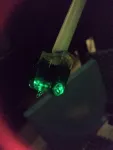(Press-News.org) Researchers at the National Institute of Standards and Technology (NIST) and collaborators have demonstrated an atom-based sensor that can determine the direction of an incoming radio signal, another key part for a potential atomic communications system that could be smaller and work better in noisy environments than conventional technology.
NIST researchers previously demonstrated that the same atom-based sensors can receive commonly used communications signals. The capability to measure a signal's "angle of arrival" helps ensure the accuracy of radar and wireless communications, which need to sort out real messages and images from random or deliberate interference.
"This new work, in conjunction with our previous work on atom-based sensors and receivers, gets us one step closer to a true atom-based communication system to benefit 5G and beyond," project leader Chris Holloway said.
In NIST's experimental setup, two different-colored lasers prepare gaseous cesium atoms in a tiny glass flask, or cell, in high-energy ("Rydberg") states, which have novel properties such as extreme sensitivity to electromagnetic fields. The frequency of an electric field signal affects the colors of light absorbed by the atoms.
An atom-based "mixer" takes input signals and converts them into different frequencies. One signal acts as a reference while a second signal is converted or "detuned" to a lower frequency. Lasers probe the atoms to detect and measure differences in frequency and phase between the two signals. Phase refers to the position of electromagnetic waves relative to one another in time.
The mixer measures the phase of the detuned signal at two different locations inside the atomic vapor cell. Based on the phase differences at these two locations, researchers can calculate the signal's direction of arrival.
To demonstrate this approach, NIST measured phase differences of a 19.18 gigahertz experimental signal at two locations inside the vapor cell for various angles of arrival. Researchers compared these measurements to both a simulation and a theoretical model to validate the new method. The selected transmission frequency could be used in future wireless communications systems, Holloway said.
The work is part of NIST's research on advanced communications, including 5G, the fifth-generation standard for broadband cellular networks, many of which will be much faster and carry far more data than today's technologies. The sensor research is also part of the NIST on a Chip program, which aims to bring world-class measurement-science technology from the lab to users anywhere and anytime. Co-authors are from the University of Colorado Boulder and ANSYS Inc. in Boulder.
Atom-based sensors in general have many possible advantages, notably measurements that are both highly accurate and universal, that is, the same everywhere because the atoms are identical. Measurement standards based on atoms include those for length and time.
With further development, atom-based radio receivers may offer many benefits over conventional technologies. For example, there is no need for traditional electronics that convert signals to different frequencies for delivery because the atoms do the job automatically. The antennas and receivers can be physically smaller, with micrometer-scale dimensions. In addition, atom-based systems may be less susceptible to some types of interference and noise.
INFORMATION:
Paper: A.K. Robinson, N. Prajapati, D. Senic, M.T. Simons and C.L. Holloway. Determining the Angle-of-Arrival of a Radio-Frequency Source with a Rydberg Atom-Based Sensor. Applied Physics Letters. Published online March 15, 2021. DOI: 10.1063/5.0045601
RIVERSIDE, Calif. -- A team led by a biomedical scientist at the University of California, Riverside, has developed a new RNA-sequencing method-- "Panoramic RNA Display by Overcoming RNA Modification Aborted Sequencing," or PANDORA-seq -- that can help discover numerous modified small RNAs that were previously undetectable.
RNA plays a central role in decoding the genetic information in DNA to sustain an organism's life. It is generally known as the intermediate molecule used to synthesize proteins from DNA. Cells are full of RNA molecules in complex and diverse forms, two main types ...
Although stratospheric ozone protects us by filtering out the sun's ultraviolet radiation, tropospheric ozone is a harmful pollutant. A new study has shown that ozone in the lower layers of the atmosphere decreases crop yields in maize and changes the types of chemicals that are found inside the leaves.
Ozone is formed when nitrous oxide, released from industries and tail pipes of cars, is broken down by sunlight and chemically reacts to form ozone. Researchers at the University of Illinois Urbana-Champaign have been studying the effects of ozone pollution on crops for over 20 years at a unique facility where crops can be grown under real-world farm ...
WINSTON-SALEM, N.C. - April 5, 2021 - According to the American Cancer Society, a noninvasive breast cancer called ductal carcinoma in situ (DCIS) accounts for approximately one of every four new breast cancer cases in the United States. If left untreated, DCIS has the potential to evolve into invasive cancer, so many patients choose to have breast-conserving surgery or mastectomy after a diagnosis.
However, obtaining clear or negative margins -- no cancer cells in the outer edge of removed tissue -- is critical to mastectomy success as positive margins are associated with higher rates of recurrence.
A new study from Wake Forest School of Medicine suggests removing ...
A new study published in Indoor Air provides design-based solutions on how to best use ultraviolet germicidal irradiation (UVGI) to disinfect occupied rooms without harming individuals. This research was conducted by Dorit Aviv, assistant professor of architecture and director of the Thermal Architecture Lab at the University of Pennsylvania Stuart Weitzman School of Design, Penn visiting scholar Miaomiao Hou, and Jovan Pantelic, an air quality expert at Katholieke Universiteit Leuven.
Ultraviolet germicidal irradiation (UVGI) devices use short-wavelength ultraviolet ...
Palmer Amaranth is a high-impact agronomic weed species that has cost the United States agriculture industry billions of dollars since its discovery outside of its native range in the southwestern U.S. and northwestern Mexico. Over the last 20 years, it has moved further north, and now poses a major threat to corn, soybean, and cotton growers across the south and Midwest regions of the United States.
It is not legal to sell any kind of seed in Minnesota if the seed lot contains Palmer Amaranth. The problem is this particular invasive species--which has shown potential to wipe out up to 91% of corn yields, 68% of soybean yields, and 54% of cotton yields-- is difficult to visibly distinguish from ...
Scientists create stable nanosheets containing boron and hydrogen atoms with potential applications in nanoelectronics and quantum information technology.
What's thinner than thin? One answer is two-dimensional materials -- exotic materials of science with length and width but only one or two atoms in thickness. They offer the possibility of unprecedented boosts in device performance for electronic devices, solar cells, batteries and medical equipment.
In collaboration with Northwestern University and the University of Florida, scientists from the U.S. Department of Energy's (DOE) Argonne National Laboratory report in Science ...
How do we become a complex, integrated multicellular organism from a single cell?
While developmental biologists have long researched this fundamental question, Stanford University biologist and HHMI investigator Dominique Bergmann's recent work on the plant Arabidopsis thaliana has uncovered surprising answers.
In a new study, published April 5 in Developmental Cell, led by Bergmann and postdoctoral scholar Camila Lopez-Anido, researchers used single-cell RNA sequencing technologies to track genetic activity in nearly 20,000 cells as they formed the surface and inner parts of an Arabidopsis leaf. Through this highly detailed technique, the researchers captured ...
PHILADELPHIA - A team led by scientists at the Perelman School of Medicine at the University of Pennsylvania has illuminated the functions of mysterious structures in cells called "nuclear speckles," showing that they can work in partnership with a key protein to enhance the activities of specific sets of genes.
The discovery, which will be published on April 5 in Molecular Cell, is an advance in basic cell biology; the key protein it identifies as a working partner of speckles is best known as major tumor-suppressor protein, p53. This avenue of research may also lead to a better future understanding of cancers, and possibly better cancer treatments.
"This study shows that nuclear speckles work as major regulators of gene expression, and suggests that ...
UNIVERSITY PARK, Pa. -- Approximately 40,000 children in the United States may have lost a parent to COVID-19 since February 2020, according to a statistical model created by a team of researchers. The researchers anticipate that without immediate interventions, the trauma from losing a parent could cast a shadow of mental health and economic problems well into the future for this vulnerable population.
In the researchers' model, for approximately every 13th COVID-related death, a child loses one parent. Children who lose a parent are at higher risk of a range ...
CHICAGO - A new study shows that youth arrested as juveniles with psychiatric disorders that remain untreated, struggle with mental health and successful outcomes well beyond adolescence.
Research from Northwestern Medicine shows nearly two-thirds of males and more than one-third of females with one or more existing psychiatric disorders when they entered detention, still had a disorder 15 years later.
The findings are significant because mental health struggles add to the existing racial, ethnic and economic disparities as well as academic challenges from missed school, making a successful transition to adulthood harder to attain.
"Kids get into trouble during adolescence.Those from wealthier families also use drugs and get into fights. But these situations are most often ...




